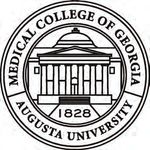History Timeline - Augusta University
←
→
Page content transcription
If your browser does not render page correctly, please read the page content below
1828-1891
1828 ■ Dr. Milton Antony leads the effort and the Georgia legislature charters the
Medical Academy of Georgia on Dec. 20 authorizing it to award a bachelor
of medicine degree. The Medical Academy would become the 13th U.S.
medical school and the 5th public medical school to be established.
1829 ■ Dr. Lewis D. Ford is selected as first dean. Classes begin at Augusta’s City
Hospital with three faculty and seven students.
■ The state legislature changes the name to the Medical Institute of Georgia and
authorizes it to award the doctorate of medicine.
1833 ■ The first four students graduate
■ The state legislature changes the institution’s name to the Medical College of Georgia.
1835 ■ The medical college occupies the Old Medical College building, its first dedicated academic
home, on Telfair Street on land conveyed by the trustees of the Academy of Richmond County.
It houses the teaching facilities of the college through 1912.
1861 ■ Classes are suspended during the Civil War, until 1865.
1873 ■ An agreement is made for affiliation with the University of Georgia, though separate governance
and financing are maintained. The name is changed to the Medical Department of the
University of Georgia.
1888 ■ The first residency program begins at City Hospital when faculty decide to appoint the first
honor student in each class as house physician at the hospital upon graduating.
1891 ■ The MCG Alumni Association is organized. The first annual meeting is held the following year.1911-1939
1911 ■ In response to the widely-accepted (Abraham) Flexner Report, which called for strengthening
medical schools’ curriculums, improving clinical instruction and providing better lab facilities,
the University of Georgia formally takes over property and assets of the medical school,
although the school remains in Augusta.
1913 ■ With the need for improved facilities,
classes relocate from the Old Medical
College building to the renovated Newton
Building on Railroad Avenue, which had
previously served as the Augusta
Orphanage Asylum.
1915 ■ University Hospital, built by the City of
Augusta, opens as the teaching hospital
for the Medical Department, replacing the
Lamar and City Hospitals. The Lamar Hospital,
which opened in 1895, had served
African-Americans in the community.
The new University Hospital maintained
separate wings for whites and African-Americans.
1920 ■ The first known class ring with the skull and crossbones
belongs to Dr. H.G. Weaver, Class of 1920.
The ring design remains the same today.
1921 ■ The first female, Loree Florence, is admitted to MCG, graduating in 1926. Dr. Florence also
works as a lab technician, which prevents her from taking a full schedule and graduating
in four years.
1923 ■ Dr. Virgil P. Sydenstricker, chair of the MCG Department of Medicine, publishes a report of
the first documented case of sickle cell disease, with full autopsy findings.
1926 ■ MCG charters a chapter of Alpha Omega Alpha Honor Medical Society, making it the first
chapter in Georgia.
1931 ■ A gift from Bowdre Phinizy, former owner and publisher of the Augusta Herald and the
Athens Banner-Herald, and his wife Meta Charbonnier Phinizy, in memory of her father,
Leon Henri Charbonnier, establishes the first endowment in MCG’s history. The chair is
fully funded in 1961 and its first recipients are cardiothoracic surgeon and 1943 MCG
graduate Dr. Robert G. Ellison and biochemistry professor and eventual founding dean of
The Graduate School, Dr. Sam Singal.
1933 ■ Due to the Great Depression, the Board of Regents closes the UGA Medical Department.
However, due to outcry from alumni and citizens across the state, and the support of
Gov. Eugene Talmadge, the regents reinstate the Medical Department, renaming it the
University of Georgia School of Medicine.
1937 ■ Basic science classrooms and labs find a home with the construction of the Dugas Building,
named in honor of former Dean, Dr. Louis Alexander Dugas.
1939 ■ Dr. Sydenstricker is nominated for a Nobel Prize in Physiology or Medicine for his research
on the use of nicotinic acid in pellagra therapy.1942-1967
1942 ■ To aid the WWII effort, the medical school begins a three-year accelerated program.
1945 ■ Dr. William Hamilton, chair of the
combined MCG Department of Physiology
and Pharmacology, invents the Hamilton
Manometer, which measures blood flow
and pressure in the cardiovascular system,
paving the way for cardiac catheterization.
1948 ■ Dr. Raymond P. Ahlquist, a pharma-
cologist and later MCG associate dean for
basic sciences, publishes research that lays
the groundwork for beta blocking drugs.
He later becomes MCG’s first recipient of
the Albert Lasker Award for Clinical
Medical Research.
1950 ■ The Board of Regents makes the medical school an independent unit of the University System
of Georgia, restoring the name Medical College of Georgia and changing the executive title
from dean to president. Dr. G. Lombard Kelly, a 1924 MCG alumnus and dean, serves as
first president.
1951 ■ The legislature authorizes the establishment of a state teaching hospital and names it for the
late Gov. Eugene Talmadge.
1954 ■ Five physicians contribute private funds to help form the MCG Foundation.
1956 ■ Eugene Talmadge Memorial Hospital
opens as MCG’s teaching hospital,
making it an academic medical center.
■ The first open-heart bypass surgery in
Georgia is performed at MCG by
Dr. Ellison.
1957 ■ Drs. Hervey Cleckley and
Corbett Thigpen, psychiatrists and
faculty in the MCG Departments of
Psychiatry and Neurology, present the first
case study documenting a patient displaying
more than two personalities, resulting in the
book and movie The Three Faces of Eve.
1963 ■ The first freestanding library opens, later named for
prominent MCG physician, scientist and
faculty member, Dr. Robert B. Greenblatt.
■ The PhD in biomedical sciences program begins.
1967 ■ MCG integrates, admitting its first African-American
students, Drs. Frank M. Rumph and
John T. Harper, who graduate in 1971.1970-1998
1970 ■ The Student Educational Enrichment Program, a summer pipeline program for students interested
in health sciences, is founded.
1977 ■ The first Hooding Ceremony is held.
1988 ■ Due to the building’s historical significance and architectural distinction, the Old Medical College
is listed on the National Register of Historic Places with the National Park Service.
1992 ■ Drs. Robert Adams, neurologist, and Virgil C. McKie, pediatric hematologist/oncologist,
identify painless transcranial Doppler as the first noninvasive method for identifying children with
sickle cell disease who also are at risk for stroke. Later studies show that regular blood transfusions
can significantly reduce stroke risk and help change sickle cell treatment for children.
1996 ■ The first White Coat Ceremony is held.
1997 ■ The MCG Foundation receives a gift of more than $17 million from the estate of Augusta radio
newsman and entrepreneur George Weiss. At the time, it was the largest single donation ever
made to the college.
1998 ■ Drs. David Munn, a pediatric
hematologist/oncologist and 1984
MCG graduate, and Andrew Mellor,
an immunologist, identify the enzyme
IDO’s role in preventing a mother’s
immune system from rejecting a fetus.
Their subsequent findings show tumors
use IDO to protect themselves and
suppressing IDO as a novel cancer therapy.2000-2009
2000 ■ The MD/PhD Program, a joint effort with the University System of Georgia, is founded.
2004 ■ A groundbreaking study, led by MCG allergist and immunologist Dr. Dennis Ownby,
overturns long-held beliefs and shows that children raised in homes with dogs and cats actually
have less risk of developing allergies and asthma.
2005 ■ The first regional campus, for
third- and fourth-year students,
in MCG’s statewide educational
network opens. The Southwest
Campus based in Albany is
headquartered at Phoebe Putney
Memorial Hospital.
2006 ■ MCG increases first-year
enrollment from 180 to 190,
the first increase since 1974.
2007 ■ MCG announces plans for the
Southeast Campus, a regional
clinical campus to be based in
Savannah/Brunswick. The first
students begin living and learning there in 2011.
■ The State of Georgia appropriates funds to study expanding medical education.
When the FY 2008 state budget is passed, it includes $2.8 million to expand student
capacity at the Medical College of Georgia.
2008 ■ The Board of Regents accept a January report from consulting firm Tripp Umbach on how
best to expand medical education.
■ The Board authorizes the purchase of the adjacent Gilbert Manor public housing property,
enabling campus expansion. The Augusta Commission provides $10 million to purchase
the property, laying the groundwork for a future academic home for MCG.
2009 ■ The Board of Regents approves the Medical Partnership, a second four-year campus of
MCG in Athens in partnership with the University of Georgia. The first 40 students enroll
in 2010, increasing MCG’s first-year class size to 230 students.
■ MCG announces plans for the Northwest Campus, a regional clinical campus to be based
in Rome. The first students begin living and learning there in 2013.2010-2020
2010 ■ The Board of Regents approves changing the university’s name to Georgia Health Sciences
University, retaining the name Medical College of Georgia for the medical school. These
changes are effective in February 2011.
2012 ■ Dr. J. Harold Harrison, a renowned vascular surgeon and a 1948 MCG graduate, and his wife,
Sue W. Harrison, give $10 million to support construction of a new academic home.
2013 ■ The Board of Regents approves the consolidation of Augusta State University and Georgia
Health Sciences University, creating Georgia Regents University. The name Medical College of
Georgia is again retained for the medical school. In 2015, the university’s name is changed to
Augusta University.
■ MCG receives a $66 million gift, from Dr. Harrison’s estate, to establish 10 new endowed chairs
for faculty and the first full-tuition scholarships for students.
■ The MD/MBA program begins.
■ The BS to MD program is founded.
2014 ■ The J. Harold Harrison, M.D. Education Commons, the academic home of MCG, opens in
August. Students begin attending classes there in January 2015.
2015 ■ The MD/MPH program begins.
2018 ■ Plans are announced to grow MCG’s class size to 260 students by the Fall of 2024, marking the
first class size increase since 2010, and to 300 by 2028.
2019 ■ MCG announces a redesign of its four-year core MD curriculum to three years to enable students
– beginning with those in the Class of 2024 – to better tailor their fourth-year learning experience.
The redesign provides a more efficient pathway into primary care for a percentage of students.
The MCG 3+ Primary Care Pathway allows students who commit to primary care practice in rural or
underserved Georgia to graduate in three years and immediately enter a residency program in
Georgia in either emergency medicine, general surgery, family medicine, internal medicine,
obstetrics and gynecology, pediatrics or psychiatry. Dependent on funding, those students would
receive a scholarship in exchange for service. The majority of students will spend the fourth year of
medical school honing clinical and research skills or completing a dual degree.
2020 ■ The AU/UGA Medical Partnership grows from 40 to 50 students per class, with plans to grow to 60
in 2021. The medical school, already with one of the largest class sizes in the country, also announces
plans to grow the class size at the main campus in Augusta, from 190 to 200 students per class
beginning in 2021, eventually growing to 240 by 2028, and bringing MCG’s total class size to 300.You can also read



























































